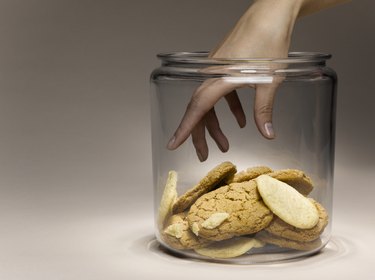Things You'll Need
Stoneware cookie mold
Recipe and ingredients for cookie-mold dough
Rolling pin
Baking sheet
Cooking oil spray
Extra flour

Baking cookies with stoneware cookie molds is a time-honored tradition. Instead of cutting cookies out of a dough that has been rolled flat on a pastry board, dough is pressed into the mold to shape it. The molds give the dough much more detail than any cutout could. If you use a mold-specific recipe for the dough, the shapes of the molds will be maintained throughout the baking process. The recipes are easy to make and the molds are easy to use.
Step 1
Follow the directions for making the dough. Use a cookie dough recipe that is specifically formulated for cookie molds. The consistency and proportions of the ingredients will be slightly different from that for rolled-out cookie dough. Preheat your oven according to the recipe.
Video of the Day
Step 2
Chill the dough before baking to facilitate ease of handling. However, some chocolate chip cookie recipes will specify that you should not chill it. Follow this advice because the cookies will be too crumbly if you chill this particular dough.
Step 3
Start with a clean stoneware cookie mold. Use a pastry brush and briskly brush out the mold before washing it in hot, soapy water. Make sure it is totally dry before the next step.
Step 4
Spray a very light coat of cooking oil evenly on the mold. You can also use a pastry brush to apply the light coat of oil. In either case, make sure the coating is as light as possible. If it is too thick, it will combine with the flour in the next step to act as a glue and your dough will stick. Wipe the mold with a paper towel if there is too much oil.
Step 5
Sprinkle a little flour evenly over the oiled mold, shake it to evenly coat, and tap the excess flour out.
Step 6
Take a ball of dough (the amount will depend on the size of your stoneware mold) and press it into the mold. Work from the middle outward to make sure no air gets trapped inside. Use the rolling pin to even out the surface then pinch off any excess dough.
Step 7
Tap the mold sharply two or three times at a 90-degree angle on the counter or cutting board to loosen the dough.
Step 8
Unmold the dough once it is loose onto an ungreased baking sheet, ensuring the molded side is up.
Step 9
Repeat steps 5 through 8 until you have enough cookies to fill the baking sheet. Do not re-oil the mold each time. There is enough oil from the shortening in the dough to leave a film to hold the next coat of flour. Bake the cookies according to the recipe you are using.
Tip
If dough sticks in the mold, use a dry, stiff-bristled brush to brush it out of the mold. Proceed with flouring the mold for your next cookie; there should be enough oil left on the mold already.
Wash the stoneware mold at the end of your baking session. Scrub with a stiff brush in hot, soapy water and dry on a rack.
You can also use your stoneware cookie mold to mold marzipan or chocolate candies, or to make paper casting.
Warning
If you use a regular cookie dough recipe for a cookie mold, the cookies may not hold the detail of the mold during baking, or the cookies may be too hard or too soft. It is well worth the effort to use a mold-specific recipe.
Video of the Day